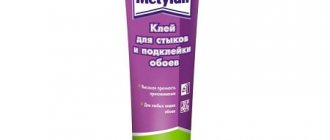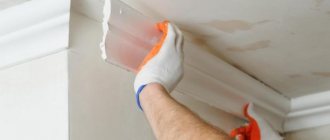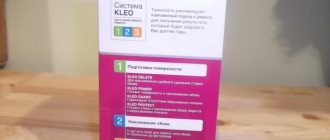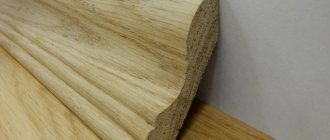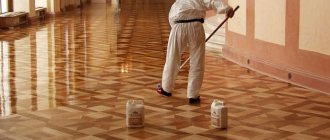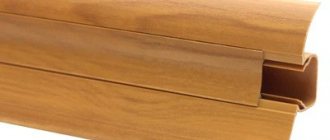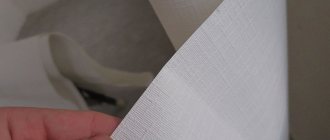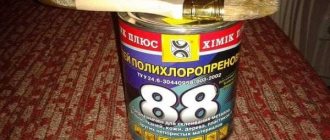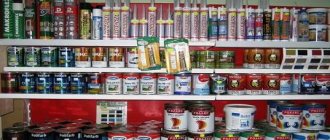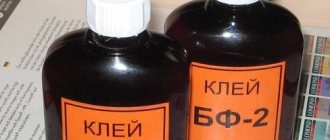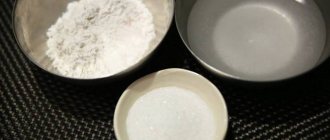- 0.1557s
- ©2018 All rights reserved
The modern construction market offers consumers the use of a wide variety of materials for cladding premises for various purposes.
The ability to separate the ceiling and walls can be achieved using a ceiling plinth.
Plus, thanks to it you can achieve originality in design.
This accessory deserves special attention.
This is due to the fact that the elements are made from a variety of materials, each of which has certain properties. Therefore, in order to glue such a plinth, it is necessary to use an adhesive suitable for it.
Before starting such work, you should adhere to certain rules:
- If there is plaster on the surface, it must first be removed and the base coated with a primer;
- The glue is applied in a thin layer evenly over the entire surface to be glued;
- When working with gluing skirting boards, the glue is applied in a dotted manner;
- Use glue in rooms with good ventilation.
Adhesive for polyurethane ceiling plinths
The advantage of polyurethane skirting boards is that this material itself is flexible, so it can be easily glued to ceilings with uneven surfaces, without fear of breakage or deformation of the product.
With the advent of polyurethane skirting boards, it became much easier to carry out repair work, because until that moment they used gypsum stucco molding, the installation of which was complex and time-consuming.
Kinds
Today, the construction market offers a variety of ceiling plinths to choose from. Let's look at the three most popular types:
- Foam plastic - has the lowest cost, high fragility and brittleness, is not plastic, it is forbidden to use with glue that contains solvents.
- Polyurethane - has high strength, and due to its flexibility it can be installed on round walls, interacts well with all types of adhesives, and has a high cost.
- Plastic is attractive, imitates a carved structure made of metal, stone, wood, and belongs to the middle price category.
Do not forget that the plinth is only a decorative element and hanging anything on it is contraindicated, regardless of its type.
The best glue for this type of product is “Moment”.
Other polymer-based varieties are also suitable, and even liquid nails with various silicone-based sealants.
But their use is not so effective, because “Moment” dries quickly, and due to its excellent properties, the adhesion to the surface is more dense.
It is recommended to use it with a special sealant gun.
If you choose glue that dries less quickly, you will have to stand with your hands raised high, holding the baseboard for a long time, since polyurethane is heavy and can fall off.
This is not very convenient, because your hands will quickly get tired, and you won’t be able to press the product tightly to the surface.
Polymer-based adhesives
Polymer compounds are the most popular option for fastening ceiling skirting boards. They have an excellent astringent base, are characterized by quick drying and good adhesion, so they are quite suitable for deciding what glue to use to glue the ceiling plinth. The most common brands are Titan and Moment.
Titan adhesive solution is created on the basis of polymer compounds and can be used to work with skirting boards made of various materials. Titanium has the following advantages:
- Can be used for work indoors and outdoors.
- High resistance to temperature changes.
- Resistant to high humidity.
- Quick adhesion to the work surface and drying.
- Viscous base.
- Good elasticity.
- Reasonable price.
Moment adhesive for ceiling skirting boards is also very popular among Russian consumers. However, this brand is characterized by a fairly high price and short drying time. In addition, the composition can damage the front surface, so care and precision are required when working with it. If glue gets on any surface, immediately remove the composition with a dry cloth. In the process of gluing the plinth with the “Moment” composition, you should firmly press the product against the working surface and hold it in this position until the glue dries completely. This is the only way to avoid the skirting boards shifting from the intended level. When working with Moment glue, regular ventilation of the room is required.
In addition to these brands, to answer the question of what glue to use to glue skirting boards to the ceiling, there are many other compositions that are characterized by different properties and have different costs.
Adhesive for foam products
Polystyrene foam is a very light material, so products made from it can be glued with various types of glue. The only one that is not suitable for use for this material is that it contains a solvent. This will render the baseboard unusable.
Very often, polymer adhesive such as “Titanium” or “Moment” is used to glue the foam plinth.
These brands are widely used due to their high qualities. They have a good astringent base, plus, they dry very quickly and hold the elements securely.
In addition to these options, there are other adhesive compositions that are similar to these types, but their adhesive ability is worse.
Thus, liquid nails are safe for foam baseboards and other materials.
They are well able to hold the baseboard for a long time. This glue is based on neopropylene, which has a pungent odor. If it is handled carelessly before it dries, it may cause harm to human health.
Acrylic-based liquid nails are safe, but they are less effective.
Polystyrene foam can be glued with acrylic-based putty.
It is used by many professional tilers because it is easy to use:
- There is no need to hold the plinth pressed to the surface for a long time until it sets;
- This composition can be simultaneously used to seal the cracks between the baseboard and the wall. If there are irregularities, they can be easily smoothed out.
With the help of putty, the baseboard is held securely; in addition, it can be used indoors, as it is safe for health.
Liquid Nails
For many home craftsmen, the task of which glue is best for gluing wooden ceiling plinths is considered quite difficult. To glue wooden skirting boards, it is best to use liquid nails, and for greater structural strength, strengthen the fasteners with screws. In construction stores, liquid nails are presented in two versions: acrylic neopropylene compounds. The second option is based on organic compounds, so its use is accompanied by the release of a pungent odor that poses a danger to human health. Therefore, any work using such glue is best done in protective clothing and a respirator, and the room is regularly ventilated. The main advantage of liquid nails is their good resistance to high humidity.
When using acrylic-based liquid nails to answer the question of what glue to use to glue the ceiling plinth, you should know that it cannot be used in rooms with high humidity, however, such compositions do not emit a strong odor and are completely safe for human health. The disadvantages of liquid nails are quite significant, including low adhesive properties, weak adhesion and long drying.
It is very important to understand the following:
- In rooms with high humidity, it is better to use silicone-based compounds.
- To fix gypsum skirting boards, it is recommended to use a mixture of gypsum, primer and PVA glue.
- Massive stucco molding should be additionally secured with screws or dowels.
How do we glue the polystyrene skirting board?
Polystyrene is a very beautiful material, so ceiling plinths made from it have an attractive appearance, which makes it in demand.
There are some features in the installation of such a product that must be taken into account when choosing an adhesive.
The main thing is to use glue with a transparent structure, polymer-based, and does not contain fillers. The Titan adhesive composition is excellent for these purposes.
It is completely transparent, therefore it is used for expensive materials, since the possibility of damage is eliminated. This substance is best for polystyrene, but it can be used on other materials.
Another suitable adhesive for polystyrene ceiling plinths is ECO - HACETEXTRA.
It is intended for gluing ceiling tiles, baseboards and other products made from materials such as polystyrene, cork, natural wood, ceramics, glass, artificial leather to surfaces made of concrete, brick, plaster, wood and gypsum boards.
These types of adhesives are universal. During their application, it is recommended to hold the plinth for some time to ensure proper and high-quality gluing.
Titanium
"Titan" is an adhesive with an excellent reputation. The advantage of the product is its versatility: it is available in a wide range. The composition is capable of gluing not only ceiling plinths, but also linoleum, parquet boards, floor plinths and even ceramic tiles. Working with artificial leather and chipboard will be successful. Titanium is ideal for gluing foam skirting boards.
Titan contains polymer materials of a modern formula; there are no fillers. When using, there is no need to worry about expensive finishing materials, and all thanks to the transparent formula. In case of careless work, excess glue is easily removed from the front side of the fillet, walls and ceiling, and does not leave streaks. The only disadvantage of using such glue is that you need to hold the part for a while so that it grabs firmly, and your hands quickly become numb when raised.
Prices for these types of glue
Price categories for all types of adhesive compositions may vary slightly in different cities.
They are quite affordable in price.
The most expensive of them is “Moment”. In addition, it is consumed to a greater extent. The consumer should choose which glue to use independently, based on financial capabilities and the material of the baseboards.
Stretch ceilings » Components and accessories
Assortment of glue for baguette: how not to make a mistake with the choice?
Glue putty for ceiling plinth
When choosing such an adhesive composition, you should pay attention to the components included in the putty. Acrylic putty deserves special attention. It can be found in any hardware store; ease of use, compliance with standards and multifunctional use have made a good advertisement for this composition.
The price of adhesive for foam ceiling tiles can also vary, due to the large number of products of this profile. There is plenty to choose from, but you need to know what to buy and how to choose. Particular attention to the manufacturer. If domestic production, it is better to choose a European analogue.
The choice between the quality of work and the cost of finishing materials is difficult, but you will have to make this choice.
Adhesives-polymers for special purposes – “Moment”, “Titan”
Advantages: excellent characteristics of the binder base, quick adhesion to the surface, strength and reliability of holding the glued elements. These adhesive solutions are recognized as the best for attaching baguettes.
Special glue contains a solvent, the function of which is to maintain it in a liquid state. It is for this reason that you have at your disposal the following adhesive compositions intended for gluing foam baguettes - liquid nails and putty.
Gluing the ceiling plinth
Surely, everyone knows firsthand that repairs are a rather lengthy, labor-intensive and expensive process.
Therefore, by starting it, we hope for a speedy completion of the repair work and a long-term preservation of the results obtained. And for this you will need high-quality and reliable materials. Moreover, such a requirement is true not only for wallpaper, floor and ceiling coverings, but also for glue for ceiling plinths.
This decorative element made of polystyrene foam or polystyrene foam helps to hide the not always ideal joint between the walls and the ceiling. And in order for it to look neat and hold tightly, you need to choose the right glue to fix it.
Adhesive acrylic putty
Solving the question of which glue is best for gluing the ceiling plinth using this option allows you to skip the stage of leveling the surface before gluing the plinth. Using putty, you can eliminate minor defects in walls and ceilings in the form of depressions and bulges. Among the many advantages, the following can be highlighted:
- Strong and reliable fastening of products to the working surface.
- Simple and easy to use.
- Affordable price.
- Ability to carry out the process independently.
- No substances harmful to human health.
Using acrylic adhesive putty for ceiling plinths, you can firmly and reliably attach foam and polystyrene plinths to the ceiling, which begin to melt when using adhesive compositions based on organic solvents.
It is recommended to glue skirting boards to the ceiling using putty immediately before finishing the walls; the composition should be evenly distributed over the work surface and the product should be glued. Excess glue can be removed with a rubber spatula or a damp sponge.
How to choose ready-made glue
It is very easy to determine the required number of standard 2-meter plinth blanks.
It is enough to measure the perimeter of the room to be covered and round up to an even number of meters. The resulting value must be divided by 2 (the length of one plinth) - this will be the required number of plinths. It’s worth adding one more blank to it just in case.
Now you need to choose the glue. All adhesives for ceiling plinths on the market today are divided according to their composition into polymer and acrylic. Moreover, each has its own advantages and disadvantages.
Polymer compositions are transparent, durable and moisture resistant, but contain a chemical solvent that keeps them in a liquid state. And until complete drying, which can last up to a week, an unpleasant odor will be felt in the room.
Acrylic adhesives are water-based, so they do not have a pronounced odor. But they are not intended for use in rooms with high humidity levels.
Thus, when deciding which glue to use to glue the baseboard to the ceiling, you need to proceed from the purpose of the room. For example, if the renovation is taking place in a nursery, then you should prefer safe acrylic glue. And for ceilings in the bathroom or kitchen you will have to consider one of the polymer samples.
What products are used for gluing skirting boards?
To apply a ceiling plinth, you need to purchase the right emulsion for this process, but there are a huge number of manufacturers and their products on the construction market. Therefore, you should figure out which product is best for gluing skirting boards.
Polymer adhesives
Among the polymer adhesives suitable for gluing ceiling skirting boards, the most used are “Titan” and “Moment”. With their help, ceiling plinths are glued quickly and efficiently, because they have an excellent astringent base. Although there are many different adhesive solutions available on the construction market, as a rule they are an order of magnitude worse than those described above.
Something to remember! Almost all polymer adhesives contain a solvent, which allows the mixture to be in liquid form. Therefore, it is not recommended to glue skirting boards made of materials sensitive to aggressive environments, such as foam plastic, with these compounds.
Liquid Nails
Liquid nails are another type of adhesive used to glue ceiling plinths. Since liquid nails are safe for almost all ceiling elements and can reliably hold skirting boards for many years. In this case, the mixtures are divided into:
- Acrylic liquid nails, which are absolutely environmentally friendly, but have a base that is not resistant to moisture, so they can only be glued to such solutions in dry rooms.
- Liquid nails based on neopropylene have an unpleasant, pungent odor because they contain an organic solvent. If liquid nails are used without following safety instructions, they can have serious effects on the body. Also, the pungent odor present disappears after the mixture dries completely. Although gluing ceiling plinths with neopropylene liquids is ideal in places with high humidity.
Acrylic putty
This material for gluing skirting boards is widely used by professional builders, because gluing elements with acrylic putty is “easy as pie.”
Among the advantages of the material are:
- Ease of installation. To install the elements, just apply the mixture and press the baseboard to the surface. Long pressing and waiting for the material to grab is not necessary;
- The versatility of the material. In addition to gluing skirting boards, acrylic putty can be used to seal gaps between surfaces and the skirting board, as well as smooth out unevenness;
- Safe to use. Since the putty does not contain various solvents and has no pungent odor, its use is absolutely safe for health.
How to make your own adhesive solution?
In order not to rack your brains with choosing a mixture, you can make your own glue for skirting boards. To produce the adhesive mixture you will need:
- pure water;
- PVA glue;
- finishing putty mixture;
- a clean container for creating an adhesive solution.
- Initially, putty is poured into a dry, clean container, to which PVA glue is added. The mixing ratio is 1:4, that is, only one part of glue is added to four parts of putty.
- Then everything is mixed and water is gradually added. The result should be a homogeneous mixture with the consistency of thick sour cream. After which the adhesive solution settles for about 10 minutes and everything is thoroughly mixed again.
- After repeating the stirring procedure, the solution is left for 1-2 hours, after which it is ready for use. If everything is done correctly, the solution should be homogeneous, without lumps or clots.
Important! All detected lumps and clots should be removed immediately.
Assortment of polymer-based adhesives
Despite significant disadvantages, the most popular are polymer-based adhesives - “Moment” or “Titan”. Buyers value them for their reliability and versatility.
Various modifications of these adhesives differ from each other in their setting speed and resistance to low temperatures. There are samples designed for gluing almost wet parts, and there are those that set in seconds. This is very convenient when working near the ceiling.
In addition, with such material it does not matter at all what the ceiling plinth or any other parts are glued to. After all, such glue is ideal for fastening elements of wooden furniture, linoleum, carpet and artificial suede.
Regardless of whether you choose acrylic or polymer glue, the required number of packages will be determined by the volume of each of them and the parameters of the skirting boards - the width of the technological surfaces and weight.
Usually the glue is applied dotted or in a snake pattern (in the case of heavy baseboards).
It’s good if the adhesive is applied to the wallpaper that covers the walls or ceiling of your room. All this must be taken into account when purchasing. It's best to consult the seller.
Features of foam plinth
After completing the finishing work, users are faced with the need to attach foam ceiling skirting boards. Despite the popular belief that any adhesive will do, this is absolutely not the case. It all depends on some features of the foam itself:
- it is a fragile material that can be easily damaged. That is why experts recommend using types of glue that will not cause deformation;
- polystyrene foam has low protection against various aggressive environments and chemical compounds. When working with foam skirting boards, you need to make sure that the glue does not contain carcinogenic substances that can damage the fragile texture of the foam;
- the material does not tolerate high humidity. That is why the glue must contain a minimum amount of water, and the gluing process itself is carried out in a dry room. It is not recommended to use foam skirting boards in rooms with high levels of humidity (bathroom, kitchen).
Foam plinth is an inexpensive finishing material, the use of which will allow you to obtain an aesthetic and attractive finish with significant durability parameters.
It is better to apply the glue in a wavy line
As you know, there are no absolutely straight lines in nature. What can we say about construction?
It's no secret that every wall has its own curvature. Brick buildings from the times of developed socialism are especially guilty of this. Therefore, during repairs, you often have to face the difficult task of fixing the ceiling plinth on a curved surface.
What is the best way to glue the ceiling plinth in this case? You can try to match the acrylic adhesive to the baseboards and/or coatings used to decorate the ceiling and walls. Or you can knead it yourself from simple materials at hand.
So, for 1 volume of water you need to take 1 volume of finishing (very fine) putty from any manufacturer and 1/4 volume of PVA glue.
Mix everything, knead until a homogeneous creamy mass without clots or lumps is obtained and let stand for a while (literally a few minutes). Immediately before use, the mass will need to be mixed thoroughly again. If the baseboards are not white, but some other color, then you can add a little water-soluble paint to the resulting composition until the desired shade is obtained.
This composition can be used both as glue and as putty, gluing and simultaneously covering the cracks between the baseboards and walls for 2 hours.
The resulting putty adhesive, since it is water-based, has properties similar to acrylic adhesive. Therefore, it is not suitable for rooms with high humidity.
Choosing adhesive for ceiling skirting boards is not such a difficult task. But not only the appearance, but also the durability of your repair will depend on how responsibly and competently you approach it.
Comments and reviews on the material
How to prepare an adhesive acrylic composition for ceiling plinths
Ready-made acrylic-based adhesive putty for ceiling plinths can be quite expensive, so to save money you can prepare the mixture yourself. To do this you will need the following:
- Dry putty.
- PVA glue.
- Water.
- Container for preparing adhesive composition.
The dry substance is poured into the prepared container and PVA glue is added, the components are taken in a ratio of 4:1. The mixture is mixed well and water is added in small portions. After obtaining a homogeneous suspension, the mixture is considered ready for use, and the question of which glue to use to glue the ceiling plinth can be considered resolved. Next, the composition is left for 5 minutes and mixed again until the lumps and clots completely disappear. Putty prepared in this way should be used within one hour.
Installation of plastic elements
Before installing decorative elements around the perimeter of the ceiling, you should take all the necessary measurements and create a drawing. After this, you can apply markings to the walls and cut the plastic ceiling plinth into pieces of the required sizes.
The edges of the plinths are cut at an angle of 45 degrees, the next plinth is cut in the same way, but in the mirror direction of the angle. This cutting method will allow you to connect all the elements of the decorative structure joint to joint, avoiding the appearance of cracks and gaps between them. Visually it will look like a solid structure between the ceiling and the wall.
If, when gluing the skirting boards to the wall, gaps appear under the ceiling, you can insulate them with silicone sealant and putty. Painting of decorative elements should be carried out before installation, as well as cutting.
To install plastic parts, you can use liquid nails or other adhesives. The plinth should be glued to the wall and not the ceiling, so it will not only stick better, but will also not damage the surface of the ceiling.
Sealant as an alternative to glue
As a rule, skirting boards are attached using construction adhesive or a material called final putty. Sealant is usually used as a finishing material in the final installation of fillets on the ceiling. However, sealant can do the entire job.
First, let's say a few words about preparing for work. To carefully glue the plinth, you need to clearly join it at the corners, for which you need to correctly make cuts at the ends of the corner sections. In principle, there are ready-made corners, but they are most often designed for standard 90-degree angles.
In short, for the correct cut you need to measure the angle of convergence of the walls, divide the resulting value in half and cut the baseboard at this half angle. You can use different tools depending on the density of the material - from a stationery knife to a grinder. For more precise work, they also use a special tool for cutting at an angle - a miter box.
Before you start gluing the baseboard with sealant, you must also make sure that the surface of the walls and ceiling is leveled, primed and completely processed so that there are no uneven spots, gaps or crumbling areas.
The place where the baguette will be directly attached must be moistened with water: this will prevent the sealant from drying out too quickly. Then apply a small amount of the composition to the fillet. It can be applied only to the part that is directly glued to the wall, but if the ceiling is not suspended, the sealant can be applied to both sides. After this, you need to press the plinth tightly against the wall and fix its position. The sealant will set very quickly on both surfaces, so you won’t have to stand for a long time with your hands raised under the ceiling. Residues crawling out from under the fillet must be cleaned with a spatula, and at the joints, on the contrary, everything should be treated with sealant again.
Construction adhesive “liquid nails”
Liquid Nails, Makroflex, Moment Installation Express Decor. Can be selected for almost all types of skirting boards. There are water-soluble (acrylic) and non-water-soluble. For curved surfaces it is better to use non-water-soluble reinforced compounds.
Pros: ease of applying the solution pointwise using a mounting gun; Additional fixation may only be required for highly deformable parts.
Cons: if the glue comes out somewhere on the fillet, it is impossible to remove it without leaving a stain. Only painting will help. Therefore, when purchasing, pay attention to the color (white).
Preparing the tools
Having figured out the installation method, we move on to preparing the tools.
Before you start gluing the ceiling plinth, prepare the following tools.
- For cutting: a construction knife for polystyrene foam or polyurethane, a hacksaw for metal or a fine-toothed hacksaw for plaster, a hacksaw for wood for a wooden ceiling cornice.
- For marking: level, pencil, ruler, tape measure.
- For cutting skirting boards at an angle: miter box.
- For installation: glue brush, putty spatula, screwdriver, drill, dowels and self-tapping screws for heavy moldings.
Types of skirting boards for the ceiling
Ceiling plinth for PVC panels has several names: baguette, frieze, fillet. However, the purpose of all elements is the same; they are intended to disguise and decorate the corner joints of the ceiling and walls.
When choosing a plinth, you should take into account the color scheme of the main finishing material that was used to decorate the walls and ceiling. Thanks to the wide range of skirting boards in construction stores, you can choose finishing elements to match almost any style and color. The products can be plain white or have a bright variegated color; the surface of the plinth can be smooth or textured.
Skirting boards are divided into two types:
- Baguette, which in turn can be extruded, injection or laminated. In the first case, the material is characterized by incised recesses, the second option is decorated with relief decoration. In any case, they perform a decorative function.
- The PVC profile has a triangular cross-section and is distinguished by the presence of an additional U-shaped profile. This design allows you to use elements for decorating individual areas and simultaneously attaching panels. In this case, the profile is first attached to the wall, and then plastic panels are inserted into the grooves. The profile is fastened in accordance with its purpose: to fix the ceiling panels, the U-shaped profile is directed to the side; to hold the wall panels, the profile should be directed downwards.
